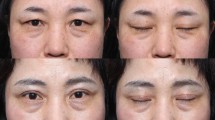Abstract
Background
Pretarsal fullness of the lower eyelid has recently gained popularity in the Asian population. Hyaluronic acid injection is a simple, nonsurgical method for creating pretarsal fullness of the lower eyelid, but the effects last only 6–12 months. A need exists for a surgical procedure with long-term effects. We describe the use of a deep temporal fascia graft for subciliary augmentation of the lower eyelid.
Methods
Between September 2009 and October 2011, seven Japanese patients underwent subciliary augmentation of the lower eyelid. This retrospective study was conducted on four of the seven patients who were followed for more than 1 year. A skin incision of approximately 1 cm was made at the lateral canthus along the subciliary crease of the lower eyelid and the skin was undermined to create a subcutaneous tunnel. A stab incision was then made 2 mm below the ciliary margin near the level of the lower lacrimal punctum. The orbicularis oculi muscle was incised under the skin incision at the lateral canthus, and the stump of the incised muscle was suspended to the periosteum of the lateral orbital rim. A deep temporal fascia graft was placed in the undermined subcutaneous plane of the lower eyelid.
Results
Lower-eyelid pretarsal fullness was maintained at more than 1 year after surgery. The eyelids regained a natural appearance, and the patients were highly satisfied. Morphometric measurements demonstrated increased projection and width of the lower-eyelid pretarsal fullness.
Conclusions
Deep temporal fascia grafting is safe and reliable for subciliary augmentation of the lower eyelid.
Level of Evidence V
This journal requires that authors assign a level of evidence to each article. For a full description of these Evidence-Based Medicine ratings, please refer to the Table of Contents or the online Instructions to Authors www.springer.com/00266.





Similar content being viewed by others
References
Hirohi T, Yoshimura K (2011) Vertical enlargement of the palpebral aperture by static shortening of the anterior and posterior lamellae of the lower eyelid: a cosmetic option for Asian eyelids. Plast Reconstr Surg 127:396–408
Tsurukiri K, Iwanami M (2005) The anatomy and clinical applications of “namidaburuko”. J Jpn Aesthet Plast Surg 27:165–172
McCurdy JA (2005) Asian blepharoplasty. In: McCurdy JA, Lam SM (eds) Cosmetic surgery of the Asian face, 2nd edn. Thieme, New York, pp 8–41
Momosawa A, Kurita M, Ozaki M, Miyamoto S, Kurachi I, Watanabe R, Harii K (2008) Transconjunctival orbital fat repositioning for tear trough deformity in young Asians. Aesthet Surg J 28:265–271
Guo L, Bi H, Xue C, Xue C, Li J, Yan C, Song J, Zhang M, Xing X (2010) Comprehensive considerations in blepharoplasty in an Asian population: a 10-year experience. Aesthetic Plast Surg 34:466–474
Sheen JH (1978) Tarsal fixation in lower blepharoplasty. Plast Reconstr Surg 62:24–31
Lewis JM (1988) Augmentation blepharoplasty. Ann Plast Surg 21:434–438
Fodor PB (1989) Lower lid “tarsal fixation” blepharoplasty: a personal technique. Aesthetic Plast Surg 13:273–277
Chen MC, Ma H, Liao WC (2013) Anthropometry of pretarsal fullness and eyelids in Oriental women. Aesthetic Plast Surg 37:617–624
Miller TA (1988) Temporalis fascia grafts for facial and nasal contour augmentation. Plast Reconstr Surg 81:524–533
Baker TM, Courtiss EH (1994) Temporalis fascia grafts in open secondary rhinoplasty. Plast Reconstr Surg 93:802–810
Besharatizadeh R, Ozkan BT, Tabrizi R (2011) Complete or a partial sheet of deep temporal fascial graft as a radix graft for radix augmentation. Eur Arch Otorhinolaryngol 268:1449–1453
Dickinson BP, Roy I, Lesavoy MA (2011) Temporal fascia for lip augmentation. Ann Plast Surg 66:114–117
Bohluli B, Amirzargar R, Moharamnejad N (2013) Augmentation of the upper lip with temporal fascia: a quantitative analysis. Aesthet Surg J 33:102–108
Schwarz GS, Spinelli HM (2008) Correction of upper eyelid retraction using deep temporal fascia spacer grafts. Plast Reconstr Surg 122:765–774
de la Torre J, Simpson RL, Tenenhaus M, Bourhill I (2001) Using lower eyelid fascial slings for recalcitrant burn ectropion. Ann Plast Surg 46:621–624
Mladick RA (1979) The muscle-suspension lower blepharoplasty. Plast Reconstr Surg 64:171–175
Conflict of interest
The author has no conflicts of interest to disclose and declares that no financial support was received for this study.
Author information
Authors and Affiliations
Corresponding author
Rights and permissions
About this article
Cite this article
Mizuno, T. Subciliary Augmentation of the Lower Eyelid in Asians Using a Deep Temporal Fascia Graft: A Preliminary Report. Aesth Plast Surg 38, 303–308 (2014). https://doi.org/10.1007/s00266-014-0275-9
Received:
Accepted:
Published:
Issue Date:
DOI: https://doi.org/10.1007/s00266-014-0275-9




